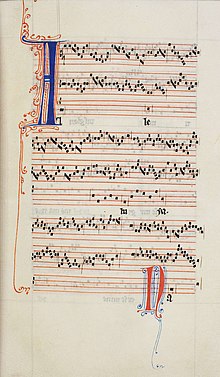Easter is the "floatiest" of floating holidays in the Western calendar. The 7th century saw a very serious debate over how the date should be determined. The debate was between the Ionan and the Roman traditions. The Ionan tradition is so-called because it was promoted by the Irish monks on the Isle of Iona.
According to John 19:14, Pilate presents Jesus to the Jews on the "day of the preparation of Passover." Early Christianity probably celebrated Easter based on Passover, which is always the 14th of the lunar month of Nisan. The First Council of Nicaea in 325 decreed that Easter should be divorced from the Jewish calendar and celebrated on a Sunday. An 84-year lunar-solar cycle was used to calculate the date for awhile.
Developing an accurate calendar based on the actual length of the year was an ongoing problem until the Gregorian Calendar, and the date of Easter was calculated in several different ways for centuries, resulting in different dates being used by different Christian factions. There was a time in Northumbria when the king and queen actually celebrated Easter separately.
Eventually, the differences became too important an issue to allow to exist, and the Synod of Whitby was conferred in 664 to resolve the issues. The strongest voice for the Roman tradition was Wilfrid, who argued:
How exactly do we calculate Easter? It's simple: Easter is the first Sunday after the first full moon after the vernal equinox. If the equinox takes place on 21 March, and is a full moon and a Saturday, then Sunday the 22nd is Easter. This actually happened in 1818, but won't happen again until 2285. If the full moon falls on the day prior to a March 22nd vernal equinox, and 28 days later the full moon falls on Sunday, then Easter is the following Sunday. In 1943, this happened, and Easter happened at its latest possible date, 25 April. This will happen again in 2038.
According to John 19:14, Pilate presents Jesus to the Jews on the "day of the preparation of Passover." Early Christianity probably celebrated Easter based on Passover, which is always the 14th of the lunar month of Nisan. The First Council of Nicaea in 325 decreed that Easter should be divorced from the Jewish calendar and celebrated on a Sunday. An 84-year lunar-solar cycle was used to calculate the date for awhile.
Developing an accurate calendar based on the actual length of the year was an ongoing problem until the Gregorian Calendar, and the date of Easter was calculated in several different ways for centuries, resulting in different dates being used by different Christian factions. There was a time in Northumbria when the king and queen actually celebrated Easter separately.
Eventually, the differences became too important an issue to allow to exist, and the Synod of Whitby was conferred in 664 to resolve the issues. The strongest voice for the Roman tradition was Wilfrid, who argued:
- it was the practice in Rome, where the apostles SS. Peter and Paul had "lived, taught, suffered, and are buried";
- it was the universal practice of the Church, even as far as Egypt;
- the customs of the apostle John were particular to the needs of his community and his age and, since then, the Council of Nicaea had established a different practice;
- Columba had done the best he could considering his knowledge, and thus his irregular practice is excusable, the Ionan monks at present did not have the excuse of ignorance; and
- whatever the case, no one has authority over Peter (and thus his successors, the Bishops of Rome).
How exactly do we calculate Easter? It's simple: Easter is the first Sunday after the first full moon after the vernal equinox. If the equinox takes place on 21 March, and is a full moon and a Saturday, then Sunday the 22nd is Easter. This actually happened in 1818, but won't happen again until 2285. If the full moon falls on the day prior to a March 22nd vernal equinox, and 28 days later the full moon falls on Sunday, then Easter is the following Sunday. In 1943, this happened, and Easter happened at its latest possible date, 25 April. This will happen again in 2038.

































